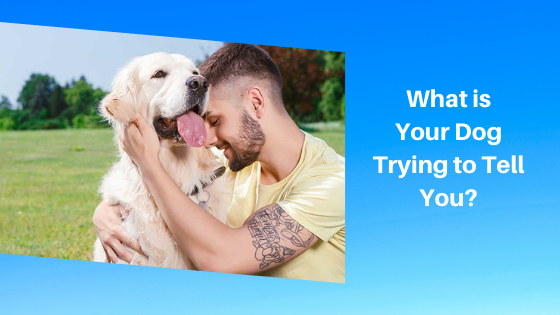What is Your Dog Trying to Tell You?
Posted by Don Hesh on Sep 23, 2020
Wouldn’t it be amazing if our dogs could talk to us and tell us exactly how they are feeling? Unfortunately, the English language will probably never leave your dog’s mouth. However, that doesn’t mean that our pets don’t already communicate with us in their own unique way. While our pups can’t use words, they compensate for it with their body language. The key to understanding out pets is translating their actions into meaningful messages that we can understand.
Here we will explain common messages your dog is trying to tell you, as well as how to pick up the signs! While each dog generally exhibits the same behaviours, not every pup will communicate in the exact same way. You need to connect with your dog and figure out their unique communication style. As a blanket rule, make sure to look at your dog’s body language as a whole - not just their eyes, facial expression or tail.
“It’s playtime”
Every dog needs an outlet to express their energy and excitement. Playtime is the best way for them to do that, other than a long or brisk walk. The signs your dog wants to play can often be confused with other unruly behaviour, so it’s critical to learn what type of play your dog enjoys the most and how they express excitement. In general, the following are the best signs your playful pooch wants to play:
“I’m feeling good”
It’s a great feeling when our pets are happy. Happiness is infectious and brings joy to our lives. You can be confident your dog is joyful when their entire body is calm, relaxed and soft. Wagging their tail is not the best sign unless the rest of their body is wagging along with it too - so keep an eye on the big picture. Other signs that your dog is feeling good may be general calm behaviour, relaxed ears and soft panting.
“Something’s scaring me”
Doggy fear can be difficult to isolate as it’s often similar to how they would express shame or guilt for their actions. If they have done something, they know you don’t like they might be scared or anxious at how you are going to react and discipline them. If they express the following behaviours, it might be a sign to take it easy on them; you don’t want your dog to be fearful or scared into submission.
“I’m not comfortable”
You never want your pets to feel uncomfortable. If your dog feels threatened or unsafe, they may react with aggression and make it dangerous for them to be in the presence of other dogs (or humans). We want to prevent our pets from being uncomfortable, to begin with. If that’s not possible, we should safely remove them from the situation when they communicate how they feel. Typical behaviours include wide-open staring eyes, bared teeth and growling, a stiff and raised tail, or raised hair along the length of their back.
Use a training collar to improve your dog’s behaviour
We all want our pets to be happy as often as possible. The key to this is understanding what they’re feeling and then communicating what you expect from them as their owner. Improving the bond you form with one another is essential to getting the best out of your dog. The best way to do this is to actively train your dog commands and tools to better manage problematic behaviours before they spiral into a damaging long-term problem.
“The greater understanding you have of one another increases the chances of a happy and well-behaved pup”
Dog training collars use mild stimuli, such as a high-pitched sound, vibration or mild-static to discourage unwanted barking and reinforce good behaviour. You can switch your dog’s training collar on when you head out for the day, take them out for a walk to the dog park or want to conduct a dedicated training session. Over time, your dog will learn what you expect from them and the behaviour you find acceptable as their owner. The greater understanding you have of one another increases the chances of a happy and well-behaved pup.
Dog Gear is an Australian company that manufacturers and sells a range of trusted, high-quality dog training collars and accessories. Now offering Afterpay as a payment method, with free Australian shipping and same-day dispatch, our products will be with you fast. Follow us on Facebook for the latest advice, updates and dog training tips!
